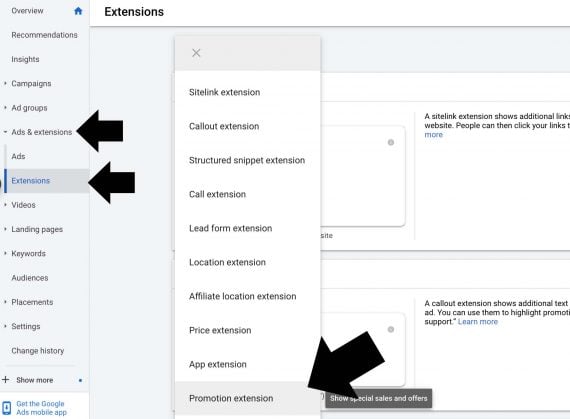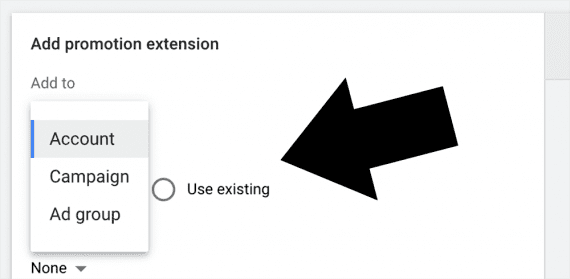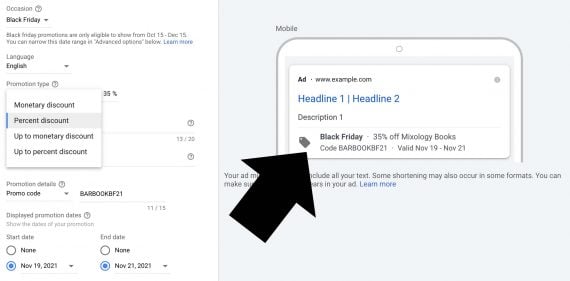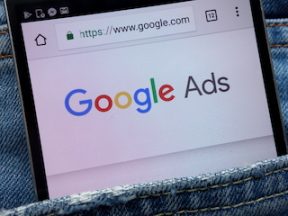The Google Ads promotion extension attaches a clickable discount offer to search ads and could boost sales for some merchants this Christmas season.
Click-through rates and conversion rates vary greatly from one business or one ad to the next. Thus one cannot say definitively that a promotion extension would drive more traffic or sales.
Nonetheless, since Google introduced promotion extensions in November 2017, pay-per-click practitioners have ballyhooed its success. For example, Pauline Jakober, CEO at Group Twenty Seven, a PPC agency, reported conversion rates as high as 13.02% for promotion extensions in a recent article for Search Engine Journal.
One caveat is that the promotion extension and its associated ads compete with other formats, such as shopping ads.
Despite the competition, setting up and using promotion extensions is straightforward and beneficial.
Note that an advertiser can link a promotion extension to a different landing page than the accompanying ad. And promotion extensions are easy to update without, for example, disrupting a regular, evergreen search campaign.
Best on Mobile
The Google Ads promotion extension can show up on any search ad. But it’s likely most effective on mobile devices. The difference is in presentation.
The promotion extension constitutes a single line of text at the bottom of a Google search ad on a desktop or laptop screen. While the opening text is bold, it is still relatively small in the context of the ad. What’s more, clicking the ad headline might seem more natural.

On a desktop or laptop computer, the promotion extension appears as an extra line of text. While it is better to have than not, it is more subtle than on mobile.
—
On a mobile device, the promotion extension stands out. It has a price tag icon and is set apart from the rest of the ad. It resembles a large button.
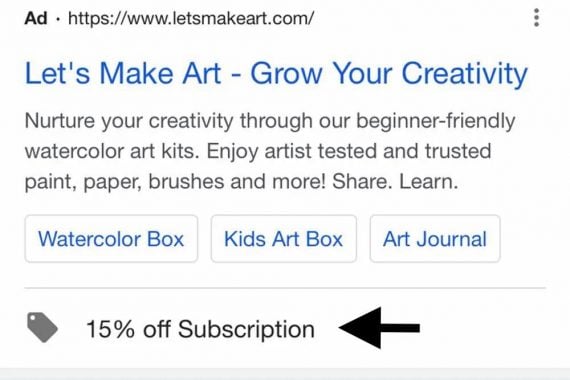
On a mobile device, the promotion extension is set apart. Notice the prominence of the subscription offer versus the rest of the ad.
Level
Advertisers can add the promotion extension when creating a new campaign in Google Ads, or by navigating to Ads & extensions > Extensions and clicking the plus sign.
—
One can add a promotion extension at the account, campaign, or ad group level. Extensions on an ad-group level supersede those on a campaign level, which supersede account level. Assign the extension to the level that makes the most sense for your promotion.
Occasion
The occasion field is optional, but it makes sense to use it if your promotion is associated with a recognizable holiday or event, such as Black Friday or Cyber Monday.
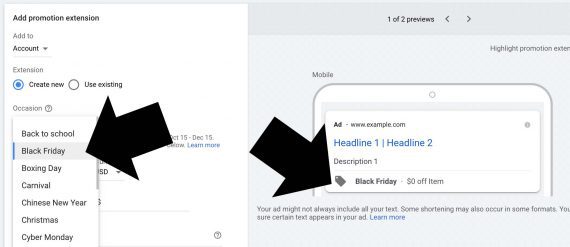
The occasion field makes sense if your promotion is associated with a recognizable holiday or event.
Occasions have specific date ranges. For example, in 2021 Black Friday and Cyber Monday promotion extensions can appear between October 15 and December 15. Google maintains a list of occasions and associated dates.
Promotion Details
The Google Ads promotion extension has four types.
- Monetary discount, such as $10 off.
- Percent discount, such as 10% off.
- Up to monetary discount, such as “Up to $10 off.”
- Up to percent discount, such as “Up to 10% off.”
Advertisers have 20 characters to describe the promoted item and space for an optional coupon code or a minimum order value. Lastly, advertisers can list the days the promotion will run.
Dates Confusion
It is worth mentioning that the promotion extension has two sets of date fields.
This first set of start and end dates is labeled “Displayed promotion dates.” These dates are displayed on computers, tablets, and mobile devices.
The second set of start and end dates are under the “Advanced options” section and labeled “Extension scheduling,” providing the days and times to show the extension.
Combined, the two sets of dates facilitate promoting a sale before it begins. An extension could launch on, say, October 10, announcing a sale that starts on October 20.

